We have given these Class 12 Biology Important Questions Chapter 5 Principles of Inheritance and Variation to solve different types of questions in the exam. Go through these Class 12 Biology Chapter 5 Important Questions, Principles of Inheritance and Variation Important Questions & Previous Year Questions to score good marks in the board examination.
Class 12 Biology Chapter 5 Important Questions Principles of Inheritance and Variation
Question 1.
Name the pattern of inheritance where F
1
phenotype
(i) resembles only one of the two parents.
(ii) does not resemble either of the two parents and is in between the two. (All India 2019)
Or
Name the respective pattern of inheritance, where F
1
phenotype
(i) does not resemble either of the two parents and is in between the two.
(ii) resembles only one of the two parents. (All India 2012)
Answer:
(i) Dominance
(ii) Incomplete dominance
Or
(i) Incomplete dominance
(ii) Dominance.
![]()
Question 2.
British geneticist RC Punnett developed a graphical representation of a genetic cross called ‘Punnett Square’. Mention the possible result this representation predicts of the genetic cross carried. (Delhi 2019)
Answer:
Punnett square helps to predict the probability of all the possible genotypes of offspring in a genetic cross.
Question 3.
Name the type of cross that would help to find the genotype of a pea plant bearing violet flowers. (All India 2017)
Answer:
To find the genotype of a pea plant bearing violet flowers, test cross would be carried out in which the plant with dominant trait, i.e. violet flowers, will be crossed with its recessive parent.
Question 4.
State a difference between a gene and an allele. (All India 2016)
Answer:
A unit of inheritance which is passed down from parent to offspring through the gametes over successive generations is known as gene. Genes consist of a pair of contrasting forms for a character that are known as alleles.
Question 5.
Give an example of polygenic trait in humans. (Delhi 2016C)
Or
On what basis is the skin colour in humans considered polygenic? (Delhi 2016)
Answer:
An example of a polygenic trait in humans is skin colour.
Or
Skin colour is considered to be a polygenic trait because it is under the control of many genes.
Question 6.
A geneticist interested in studying variations and patterns of inheritance in living beings prefers to choose organisms for experiments with shorter life cycle. Provide a reason. (Delhi 2015)
Answer:
A geneticist interested in studying variations and patterns of inheritance in living beings prefers to choose organisms with shorter life cycle, because it enables the geneticist to study many generations of the organism in a short time period.
Question 7.
Mention any two contrasting traits with respect to seeds in pea plant that were studied by Mendel. (All India 2014)
Answer:
Two contrasting seed traits studied by Mendel are
- Seed shape Round and wrinkled.
- Seed colour Yellow and green.
Question 8.
What are ‘true-breeding lines’ that are used to study inheritance pattern of traits in plants. (Delhi 2014)
Answer:
True-breeding lines are those plants, which have undergone continuous self-pollination and show stable trait inheritance and expression for several generations.
Question 9.
How many kinds of phenotype would you expect in F
2
-generation in a monohybrid cross exhibiting codominance? (All India 2014)
Answer:
In codominance, alleles are able to express themselves independently when present together. Thus, in a monohybrid cross there would be three kinds of phenotype in the F
2
-generation showing codominance.
Question 10.
Name the stage of cell division where segregation of an independent pair of chromosomes occurs. (All India 2014)
Or
Name the event during cell division cycle that results in the gain and loss of chromosomes. (Delhi 2011)
Answer:
During meiotic anaphase-I of cell division, the separation of independent pair of chromosomes occurs.
Or
Non-disjunction of chromosomes during anaphase-I of meiosis results in the gain or loss of chromosomes.
Question 11.
A garden pea plant (A) produced inflated yellow pod and another plant (B) of the same species produced constricted green pods. Identify the dominant traits. (Delhi 2012)
Answer:
The dominant trait in the pea plant is inflated green pods while the recessive trait is constricted yellow pod?
Question 12.
A garden pea plant produced axial white flowers another of the same species produced terminal violet flowers. Identify the dominant traits. (All India 2012)
Answer:
The dominant trait in the pea plant is axial violet flowers, while the recessive trait is terminal white flowers.
Question 13.
In a dihybrid cross, when would the proportion of parental gene combinations be much higher than non-parental types, as experimentally shown by Morgan and his group? (All India 2012)
Answer:
The proportion of parental gene combination is much higher than non-parental types, when the two genes show linkage and are inherited together.
Question 14.
Write possible genotypes Mendel got when he crossed F
1
tall plant with a dwarf pea plant. (Foreign 2012)
Answer:
Tt and tt (in ratio of 1:1) genotypes were obtained on crossing F
1
tall plant with a dwarf parent plant. It is a test cross.
Question 15.
Garden pea plant produced round, green seed. Another of same species produced wrinkled yellow seeds. Identify dominant traits. (Foreign 2012)
Answer:
The dominant trait in pea plant is round and green seeds, while the recessive trait is wrinkled and yellow seeds.
Question 16.
Mention two contrasting flower related traits studied by Mendel in pea plant experiments. (All India 2011C)
Answer:
The two contrasting flower traits in pea plant are
- Violet flowers and white flowers.
- Axial flowers and terminal flowers.
Question 17.
Name the contrasting pod related traits studied by Mendel in his pea plant experiment. (All India 2011C)
Answer:
The two contrasting pod related traits in pea plant are
- Inflated/Constricted shape.
- Green/Yellow colour.
Question 18.
Mention the type of allele that expresses itself only in homozygous state in an organism. (Foreign 2011)
Answer:
Recessive allele expresses itself only in homozygous condition because in the presence of a dominant allele its effect is masked.
Question 19.
Pea flowers produce assured seed sets. Give a reason. (All India 2010)
Answer:
Pea flowers produce assured seed sets because they have cleistogamous flowers, which undergo natural self-pollination.
Question 20.
Explain polygenic inheritance with the help of an example. (All India 2019)
Answer:
Refer to text ‘Polygenic Inheritance, on page no. 94 and 95.
Question 21.
When does a geneticist need to carry a test cross? (Foreign 2015)
Or
How would you find the genotype of an organism exhibiting a dominant phenotype? (Delhi 2012C)
Answer:
A geneticist needs to carry a test cross when he/she wants to determine the genotype of an organism, with a dominant phenotype trait, whether it is homozygous or heterozygous.
Or
Genotype of the dominant phenotype is determined by a test cross. In it, the F
1
progeny is crossed to its recessive parent. When F
1
progeny (heterozygous) crossed with dwarf plant, the monohybrid test cross ratio is 1 : 1. But, all tall plants are obtained when both homozygous parents are crossed.
Question 22.
Why did TH Morgan select Drosophila melanogaster to study sex-linked genes for his lab experiments. (Foreign 2015)
Or
Write the scientific name of the fruitfly. Why did Morgan prefer to work with fruit flies for his experiments? State any three reasons. (All India 2014)
Answer:
The scientific name of fruitfly is Drosophila melanogaster.
TH Morgan preferred this organism for his study because of the following reasons
- It has fast and short life cycle.
- It has’only four pairs of chromosomes.
- It reproduces quickly.
Question 23.
Give an example of a gene responsible for multiple phenotypic expressions. What are such genes called? State the cause that is responsible for such an effect. (Foreign 2015)
Or
Explain pleiotropy with the help of an example. (Foreign 2014)
Answer:
Pleiotropy is the phenomenon in which a single gene exhibits multiple phenotypic expressions. The genes exhibiting pleiotropy are called pleiotrppic genes. Pleiotropism occurs mainly because of mutation in a particular gene, e.g. phenylketonuria which is a disorder caused by mutation in the gene coding for the enzyme phenylalanine hydroxylase. In the absence of this enzyme, phenylalanine is not converted into tyrosine and accumulation of phenylalanine takes place. The affected individual shows hair and skin pigmentation and mental problems.
Question 24.
The F
2
progeny of a monohybrid cross showed phenotypic and genotypic ratio as 1 : 2 : 1, unlike that of Mendel’s monohybrid F
2
ratio. With the help of a suitable example, work out a cross and explain how it is possible. (All India 2015)
Or
Why are F
2
phenotypic and genotypic ratios are same in a cross between red flowered snapdragon and white flowered snapdragon plants? Explain with the help of cross. Delhi 2010
Answer:
The given condition represents the case of incomplete dominance. In snapdragon, the inheritance of flower colour shows incomplete dominance. Neither of the alleles of gene for flower colour is completely dominant over the other and hybrid shows an intermediate phenotype. Therefore, F
2
phenotypic and genotypic ratios are same in a cross between red flowered snapdragon and white flowered snapdragon plants.
It can be explained with the help of a cross given below
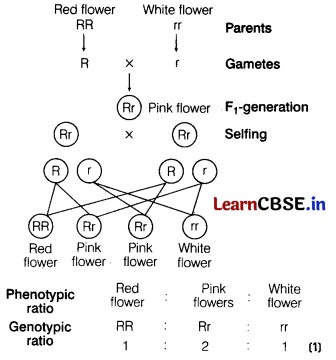
Question 25.
With the help of one example, explain the phenomena of codominance and multiple allelism in human population. (All India 2014)
Answer:
In human population, the phenomena of codominance and multiple allelism can be explained by the inheritance pattern of ABO blood groups which are controlled by three alleles, i.e. I
A
,I
B
and I.
- Codominance I A and I B both are codominant as both of them express themselves independently in blood group AB (I A I B ). There is no mixing of the effects of two alleles and the expressed phenotype is the combination of two phenotypes. They do not follow Mendelian inheritance.
- Multiple allelism In this phenomenon, genes exist in more than two allelic forms or combinations. For example, the gene for blood group exists in three allelic forms I A , I B and i. These alleles are produced due to repeated mutation of the same gene in different direction. They do not follow Mendelian pattern of inheritance.
Question 26.
Linkage and crossing over of genes are alternatives of each other. Justify with the help of an example. (All India 2014)
Answer:
Linkage is the tendency of certain loci or alleles (genes) to be inherited together. While crossing over in the segregation of genes. The former helps to preserve parental characters in offsprings whearas the latter produces new combination of characters. The genes on a chromosome either follow linkage path or crossing over to form the gametes during gametogenesis in human. Therefore, linkage and crossing over of genes are alternatives of each other.
![]()
Question 27.
In snapdragon, a cross between true-breeding red flowered (RR) plants and true-breeding white flowered (rr) plants showed a progeny of plants with all pink flowers.
(i) The appearance of pink flowers is not known as blending. Why?
(ii) What is this phenomenon known as? (All India 2014)
Answer:
(i) Blending is the mixing of two colours, but in this example red and white colours appear independently at cellular level. Thus, no blending occurs. The red and white colours reappear in F
2
-generation.
(ii) This phenomenon is known as incomplete dominance.
Question 28.
A cross was carried out between two pea plants showing the contrasting traits of height of the plants. The results of the cross showed 50% parental characters.
(i) Work out the cross with the help of a Punnett square.
(ii) Name the type of the cross carried out. (Delhi 2014)
Answer:
(i) A Punnett square representing the cross given in the question is as follows
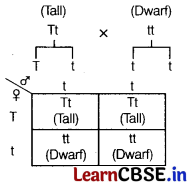
(ii) The type of cross carried out here is a test cross, in which an individual with an unknown dominant phenotype is crossed with a homozygous recessive for that trait.
Question 29.
How does the gene T control ABO blood group in humans? Write the effect the gene has on the structure of red blood cells. (Delhi 2014)
Answer:
In humans, the ABO blood groups are controlled by a gene called gene ‘I’. It has three alleles, i.e. I
A
, I
B
and i. A person possesses any two of the three alleles. I
A
and I
B
are codominant and they both are dominant over i. These alleles help to determine the blood group of a person. The plasma membrane of red blood cells has sugar polymers that protrude out from its surface and the kind of sugar is regulated by the gene ‘I’ of ABO blood group. The alleles I
A
and I
B
produce enzymes that produce A and B types of sugar respectively on the surface of red blood cells, while allele i does not produce any sugar.
Question 30.
Study the figures given below and answer the question.
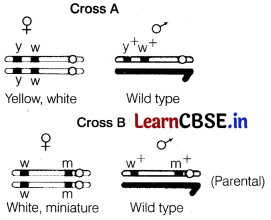
Identify in which of the crosses, the strength of linkage between the genes is higher. Give reasons in support of your answer. (Foreign 2014)
Answer:
The strength of linkage is higher in the cross A than in cross B because linkage is higher when two genes are present closely on the same chromosome than those genes which are far apart. In cross B, the chances of crossing over or recombination are higher because the genes are loosely linked.
Question 31.
A cross between a red flower bearing plant and a white flower bearing plant of Antirrhinum produced all plants having pink flowers. Work out a cross to explain how this is possible. (All India 2013)
Or
Explain the mechanism of inheritance of the progeny produced when two Antirrhinum pink flowers were crossed. (All India 2012)
Answer:
Cross of red flowered Antirrhinum with white flowered plant produces pink flowered plants. This shows incomplete dominance.
For cross, Refer to Answer No. 24.
Question 32.
Work out a cross to find the genotype of a tall pea plant. Name the type of cross. (All India 2013)
Answer:
To know the genotype of tall pea plant, test cross is to be performed. It is the cross between F
1
-hybrid and its recessive parent.
For cross, Refer to Answer No. 28 (i).
Question 33.
Differentiate between multiple allelism and pleiotropy with the help of an example of each. (Delhi 2013c)
Answer:
Differences between multiple allelism and pleiotropy are
Multiple allelism
This occurs when one trait is controlled by more than two alleles.
e.g. ABO blood grouping.
Pleiotropy
This occurs when one gene controls many traits.
e.g. Phenylketonuria (PKU).
Question 34.
In a cross between two tall pea plants, some of the offsprings produced were dwarf. Show with the help of Punnett square, how this is possible. (Delhi 2013)
Or
When a tall pea plant was selfed, it produced one fourth of its progeny as dwarf. Explain with the help of a cross. (Delhi 2010)
Answer:
Tall plants may either have genotype TT or Tt. Two tall pea plants that produce some dwarf plants among their progenies must be heterozygous with the genotype Tt. Plants with genotype TT cannot produce dwarf offspring as they lack the allele for dwarfness (t) and hence, cannot transfer it to the progeny. But, if both the parents are heterozygous tall (Tt), 25% of F, progeny would contain ‘t’ allele in homozygous (tt) condition. It can be represented using Punnett square as follows
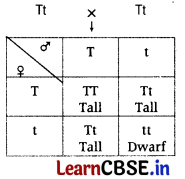
Question 35.
In a typical monohybrid cross, the F
2
population ratio is written as 3 : 1 for phenotype, but expressed as 1 : 2 : 1 for genotype. Explain with the help of an example. (All India 2013)
Or
Tallness of pea plant is dominant trait, while dwarfness is the alternate recessive trait. When a pureline tall is crossed with a pureline dwarf, what fraction of tall plants in F
2
-generation shall be heterozygous? Give reasons. (Delhi 2011C)
Answer:
In a monohybrid cross, when a pureline tall plant is crossed with a pureline dwarf plant, following ratios are produced
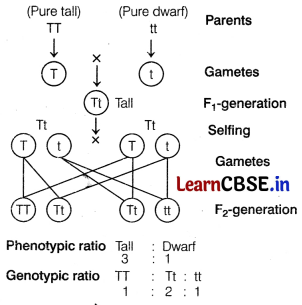
The phenotypic ratio 3 : 1 represents that 14th of F
2
plants are tall, whereas 1/4th plants are dwarf. The genotypic ratio 1 : 2 : 1 represents 1 true breeding dominant, 2 heterozygous dominant and 1 true breeding recessive progeny.
Or
Two-third of tall progenies are heterozygous because gene for tallness (T) is dominant and also expresses itself in heterozygous condition. It is due to this reason that a difference is observed in F
2
phenotypic and genotypic ratio.
Question 36.
How is the phenotypic ratio of F
2
-generation in a dihybrid cross is different from monohybrid cross? (All India 2012)
Answer:
In a monohybrid cross, the phenotypic ratio of F
2
-generation is 3 : 1, whereas in dihybrid cross, the pheonotypic ratio of F
2
-generation is 9 : 3 : 3 : 1.
Question 37.
In a dihybrid cross, white-eyed, yellow-bodied female Drosophila crossed with red-eyed, brown-bodied male Drosophila produced in F
2
-generation 1.3% recombinants and 98.7% progeny with parental type combinations. This observation of Morgan deviated from Mendelian F
2
-phenotypic dihybrid ratio. Explain, giving reasons Morgan’s observation. (Foreign 2011)
Answer:
The results obtained were due to the linkage. It is the phenomenon in which two or more linked genes are inherited together and their frequency of recombination in a test cross progeny is less than the expected 50%. In Morgan’s experiment on Drosophila, the genes for eye colour and body colour show linkage and do not allow crossing over during gamete formation. Hence, parental type progeny is in greater ratio than that of recombinants.
Question 38.
Explain the phenomena of dominance, multiple allelism and codominance taking human ABO blood group as an example. (All India 2019)
Answer:
Refer to text on page no. 93 and 94.
Question 39.
Compare in any three ways the chromosomal theory of inheritance as proposed by Sutton and Bovery with that of experimental results on pea plant presented by Mendel. (Delhi 2019)
Answer:
Through any of the given ways chromosomal theory of inheritance and experimental results presented by Mendel can be compared
- In a diploid organism, the factors (genes) and chromosomes occur in pairs.
- Both chromosomes as well as genes segregate at the time of gamete formation such that only one of each pair is transmitted to a gamete.
- A gamete contains only one chromosome of a type and only one of the two alleles of a trait.
- The paired condition of both chromosomes as well as Mendelian factors is restored during fertilisation. (Any three)
Question 40.
(i) Explain linkage and recombination as put forth by TH Morgan based on his observations with Drosophila melanogaster crossing experiment.
(ii) Write the basis on which Alfred Sturtevant explained gene mapping. (Delhi 2019)
Answer:
(i) TH Morgan studied X-linked gene in Drosophila and saw that when the two genes in a dihybrid cross were situated on the same chromosome, the proportion of parental gene combinations were much higher than the non-parental type.
He attributed this due to the physical association or linkage of the two genes on a chromosome and coined the term linkage. The term recombination describes the generation of non-parental gene combination in offsprings.
(ii) Alfred Sturtevant explained gene mapping by using the frequency of recombination between the gene pairs on the same chromosome as a measure of the distance between genes and he mapped their position on the chromosome.
Question 41.
What is a test cross? How can it decipher the heterozygosity of a plant? (All India 2016)
Answer:
Test Cross This is a method devised by Mendel to determine the genotype of an organism. In this cross, the organism with an unknown dominant genotype is crossed with the recessive parent, instead of self-crossing. For example, in a monohybrid cross, between violet colour flower (W) and white colour flower (w), the F
1
-hybrid was a violet colour flower. If all the F
1
-progenies are of violet colour, then the dominant flower is homozygous and if the progenies are in 1 : 1 ratio, then it is deciphered that dominant flower is heterozygous.
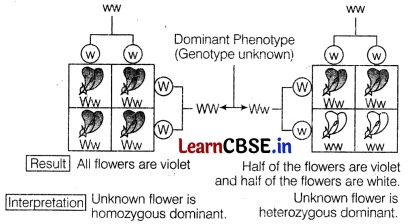
Question 42.
How would you find genotype of a tall pea plant bearing white flowers? Explain with the help of a cross. Name the type of cross you would use. (Delhi 2016)
Answer:
We can find out the genotype of a plant by test cross by allowing it to cross with its recessive parent. The tall plant may be either homozygous or hetorozygous.
Case I Tall (homozygous) pea plant with white flowers crossed with dwarf pea plant with white flowers.
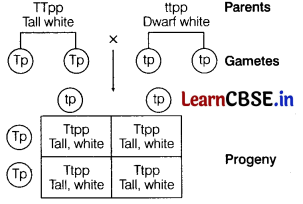
If plant produces all tall plants with white flowers as offspring, then genotype of plant is TTpp, i.e. homozygous tall plant with white flowers.
Case II Tall (heterozygous) pea plant with white flowers is crossed with dwarf pea plant with white flowers. If plant produces both tall plant with white flowers and dwarf plant with white flowers, then genotype of plant is Ttpp, i.e. heterozygous tall pea plant with white flowers.
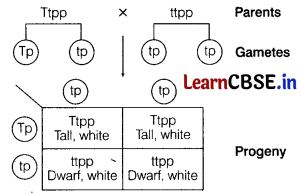
Question 43.
Although Mendel published his work on inheritance of characters in 1865 but for several reasons, it remained unrecognised till 1900. Explain giving three reasons, why did it take so long. (Delhi 2016C)
Or
Mendel published his work on inheritance of characters in 1865, but it remained unrecognised till 1900. Give three reasons for the delay in accepting his work. (Delhi 2014)
Answer:
The following are the three reasons that led to delay in accepting Mendel’s work.
- Lack of communication and less published work.
- His concept of factors (genes) as discrete units which did not blend with each other was not accepted in the light of variations occurring continuously in nature.
- Mendel’s approach to explain biological phenomenon with the help of mathematics was also not accepted.
Question 44.
Explain the laws that Mendel derived from his monohybrid crosses. (Delhi 2016C)
Answer:
From mbnohybrid crosses, Mendel derived law of dominance and law of segregation.
Refer to text on page no. 92 for detailed description of these laws.
Question 45.
A teacher wants his/her students to find the genotype of pea plants bearing purple coloured flowers in their school garden. Name and explain the cross that will make it possible. (Delhi 2015)
Answer:
Test cross is a method devised by Mendel to determine the genotype of a plant with dominant phenotype (purple flower in this case). In a test cross, the unknown dominant genotype is crossed with recessive parent (white, WW in the given case).
(i) If the progeny consists of purple and white flowers in ratio of 1:1, the purple flower is a hybrid with PW genotype. It can be seen from the given cross.
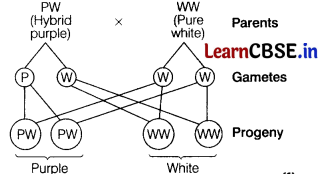
(ii) If the progeny obtained have all purple flowers, both parents are homozygous, i.e. genotype of purple flower is PP.
It can be seen from the cross that follows
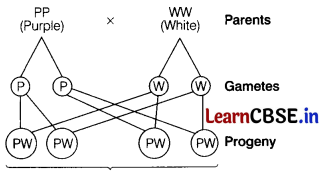
Question 46.
During a monohybrid cross involving a tall pea plant with a dwarf pea plant, the offspring populations were tall and dwarf in equal ratio. Work out a cross to show how it is possible. (All India 2015)
Answer:
In a monohybrid test cross, involving a heterozygous tall plant (Tt) and a pure dwarf plant (tt), the progeny consists of tall and dwarf plants in the ratio of 1 : 1. This can be shown as follows
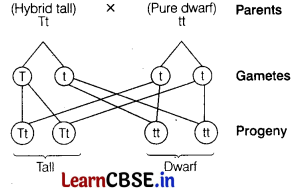
Question 47.
Explain with the help of a suitable example, the inheritance of a trait where two different dominant alleles of a trait express themselves simultaneously in the progeny. Name this kind of inheritance pattern. (All India 2014C)
Answer:
Codominance is the inheritance of a trait where two different dominant alleles of a trait express themselves simultaneously in the progeny.
For example, ABO blood groups in human population.
- Gene T for blood group exhibits three allelic forms, i.e. I A , I B and i.
- I A and I B produce RBC surface antigen A and B respectively, whereas i does not produce any antigen.
- I A and I B are codominant alleles, and they both are dominant over ‘i’ which is a recessive allele.
- In case I A and I B are present together, both express themselves equally and produce both surface antigen A and B. The resultant offspring is of ‘AB’ blood type.
| Allele from parent 1 | Allele from parent 2 | Genotypes of offsprings | Blood types of offsprings |
| I A | I A | I A I A | A |
| I A | I B | I A I B | AB |
| I A | i | I A i | A |
| I B | I A | I A I B | AB |
| I B | I B | I B I B | B |
| I B | i | I B i | B |
| i | i | ii | O |
Question 48.
Explain polygenic inheritance with the help of a suitable example. (All India 2014)
Answer:
Polygenic inheritance is an inheritance pattern controlled by three or more genes (multiple genes) and the graded phenotypes are due to the additive or cumulative effect of all the different genes of the trait, e.g. skin colour in human population shows variation.
Skin colour in humans is produced by a pigment called melanin. The quantity of melanin is due to three pairs of polygenes (A, B and C). If a black or very dark (AA BB CC) and white or very light (aa bb cc) individuals marry each other, the offsprings or individuals of F 1 -generation show intermediate colour and they are often called mulatto (Aa Bb Cc).
A total of eight allele combinations are possible in the gametes forming 27 distinct genotypes distributed into 7 phenotypes, i.e. 1 very dark,
6 dark, 15 fairly dark, 20 intermediate, 15 fairly light and 1 very light.
![]()
Question 49.
Morgan carried out several dihybrid crosses in Drosophila and found F
2
ratios deviated very significantly from the expected Mendelian ratio. Explain his finding with the help of an example. (All India 2014C; Delhi 2010)
Answer:
Morgan’s studies on Drosophila were based on the genes that were located on the X-chromosome. He found when the two genes in a dihybrid cross were situated on the same chromosome, the proportion of parental gene combinations were much higher than the non-parental type. Morgan stated this association as linkage to describe the physical association of genes on a chromosome. Recombination is a term used to describe the generation of non-parental gene combination. Morgan also found that some genes were tightly linked (low recombination) and others were loosely linked (high recombination). He concluded that in case of inheritance of linked genes, the phenotypic ratio deviates from expected 9 : 3 : 3 : 1 ratio of Mendel’s dihybrid cross.
To prove his findings, Morgan hybridised yellow-bodied and white-eyed females with brown-bodied and red-eyed males (wild type) and intercrossed their F 1 -progeny (cross A). It was observed that the two genes did not segregate independently for each other and the F 2 -ratio deviated significantly from 9 : 3 : 3 : 1 ratio.
In F 2 -generation, parental combinations were 98.7% and the recombinants were 1.3%. In another cross (cross B), between white-bodied female fly with miniature wing and a male fly with yellow body and normal wing, parental combinations were 62.8% and recombinants were 37.2% in F 2 -generation. Thus, it was proved from the crosses that the linkage between genes for yellow body and white eyes was stronger than the linkage between the white body and miniature wing.
Question 50.
(i) Write the conclusion Mendel arrived at on dominance of traits on the basis of monohybrid crosses that he carried out in pea plants.
(ii) Explain why a recessive allele is unable to express itself in a heterozygous state. (Foreign 2014)
Answer:
(i) In a monohybrid cross in pea plant, Mendel found that only dominant trait expresses itself in offspring no matter it is whether present in homozygous state (TT) or in heterozygous state (Tt). Dominant trait does not require another similar allele to produce its effect on the phenotype, in fact it has the ability to mask the effect of recessive allele. Based on this observation, Mendel proposed the law of dominance.
(ii) Since, the characters are controlled by genes which occur in pair, when two alternate forms of a trait or character (genes or alleles) are present in an organism, only one factor expresses itself in F 1 -generation. This factor is dominant, while the other factor that remains masked by the dominant factor is called as recessive.
The recessive allele is unable to express itself in a heterozygous state because it forms an incomplete or defective polypeptide or enzyme, so its expression does not contain any effect. In contrast, dominant allele can form complete polypeptide or enzyme to express its effect.
Question 51.
In pea plants, the colour of the flower is either violet or white, whereas human skin colour shows many gradation.
Explain giving reasons how it is possible. (Delhi 2013C)
Answer:
In pea plants, the colour of the flower is either violet or white because the colour is purely dependent on two alleles and the crossing between them, i.e. violet and white in the parents generation, which results in F
1
-generation. Thus, the resultant offsprings are either violet or white coloured. Hence, the inheritance pattern of flower colour in pea plant follows the law of dominance.
But in case of humans, skin colour is produced by polygenes. Such inheritance is controlled by one or more genes in which dominant alleles have cumulative effect with each dominant allele expressing a part of the trait. The full trait is shown only when all the dominant alleles are present together.
The quantity of human skin pigment melanin determines the human skin colour (i.e. very dark, dark, fairly dark, intermediate, fairly light, light and very light). Refer to Answer No. 48.
Question 52.
(i) Explain the phenomena of multiple allelism and codominance taking ABO blood group as an example. (All India 2012)
(ii) What is the phenotype of the following?
(a) I
A
i
(b) ii
Answer:
(i) Refer to Answer No. 25.
(ii) Phenotypes of given blood genotypes are as follows
(a) I
A
i – ‘A’ blood group
(b) ii – ‘O’blood group
Question 53.
A pea plant with purple flowers was crossed with white flowers producing all plants with only purple flowers. On selfing, these plants produced 482 plants with purple flowers and 162 with white flowers. What genetic mechanism accounts for these results? Explain. (Delhi 2011)
Answer:
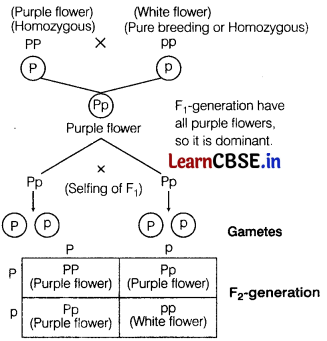
Purple flowered plants : White flowered plants are in the ratio of 482 : 162 which is approximately equal to 3 : 1.
The genetic mechanism for these results is explained below:
(i) Factors segregate from each other during gamete formation that remain together in a parent.
(ii) A homozygous parent produces all gametes that are similar, while heterozyogous parent produces two kinds of gametes in equal ratio.
Question 54.
Work out a cross between true breeding red and white flowered dog flower plants (snapdragon) upto F
2
progeny. Explain the results of F
1
and F
2
-generation. (Foreign 2010)
Answer:
For cross, Refer to Answer No. 24.
In F
1
-generation Pink flowered plants obtained. It is due to incomplete dominance.
In F
2
-generation Alleles of the hybrid (F
1
) segregate during gamete formation and the parental characters reappear without any change. So, the phenotypic and genotypic ratios in F
2
-generation are same.
Question 55.
(i) Work out the crosses so as to obtain the phenotypic ratios given below:
(a) 1 : 2 : 1 (in F
2
-generation)
(b) 3 : 1 (in F
2
-generation)
(c) 1 : 1 (in F
1
-generation)
(ii) Differentiate between pleiotropy and polygenic inheritance patterns. (All India 2019)
Answer:
(i) (a) 1 : 2 : 1 (in F
2
-generation ) is the phenotypic ratio of incomplete dominance.
Refer to figure 5.3 on page no. 93.
(b) 3 : 1 (in F
2
-generation) is the phenotypic ratio of monohybrid cross.
Refer to figure 5.1 on page no. 91.
(c) 1 : 1 (in F
1/sub>-generation) is the phenotypic ratio of test cross.
Refer to text and figure of ‘Test cross’ on page no. 91 and 92.
(ii) Differences between pleiotropy and polygenic inheritance are as follows
| Pleiotropy | Polygenic inheritance |
| Single gene product confers many physiological effects. | Single phenotypic effect is under the control of many genes. |
| The genes involved are called pleiotropic genes. | The genes involved are called polygenes. |
| e.g. phenylketonuria. | e.g. human skin colour. |
Question 56.
Differentiate between incomplete dominance and codominance. Substantiate your answer with one example of each. (Delhi 2019)
Answer:
Differences between codominance and incomplete dominance are as follows
| Codominance | Incomplete dominance |
| It is the appearance of both parental phenotypes together in the offspring when a cross is done between individuals with two different phenotypes. | It is the appearance of an intermediate phenotype, which is a combination of both parental alleles when a cross is done between individuals with two different phenotypes. |
| Both parental alleles produce their effect independently. | Effect of the two parental alleles is intermediate on the offspring. |
| Both parental alleles can be observed in the offspring. | None of parental alleles can be observed in the offspring. |
| Examples include ABO blood group, etc. Six different genotypes of human ABO blood group show four phenotypes-A, B, AB and O. | Examples include inheritance of flower colour in the dogflower, etc. Here, the genotypic ratio of F 2 remains same as Mendel’s monohybrid cross, i.e. 1 : 2 : 1, but phenotypic ratio changes from 3 : 1 to 1 : 2 : 1. |
Question 57.
(i) Write the scientific name of the organism Thomas Hunt Morgan and his colleagues worked with for their experiments.
Explain the correlation between linkage and recombination with respect to genes as studied by them.
(ii) How did Sturtevant explain gene mapping while working with Morgan? (2018)
Answer:
(i) Thomas Hunt Morgan and his colleagues worked on Drosophila melanogaster.
Relation between Linkage and Recombination:
Morgan carried out dihybrid crosses in Drosophila to study sex-linked genes. Morgan hybridised yellow-bodied, white-eyed females to brown-bodied, red-eyed males. He intercrossed their F
1
– progeny. It was observed that the two genes did not segregate independently of each other. The F
2
ratio deviated from the ratio of 9 : 3 : 3 : 1.
It was known to Morgan and his colleagues that genes were located on X-chromosomes. They noticed that when the two genes in a dihybrid cross were situated on the same chromosome, the proportion of parental combination was very high in comparison to non-parental type. He attributed this due to the physical association or linkage of the two genes. To describe this physical association of gene, he coined the term linkage. Recombination term was used to describe the generation of non-parental gene combinations. In his experiments, he observed that even when genes were grouped on the same chromosome, some genes were very tightly linked and showed very low recombination. On the other hand, loosely linked genes showed higher recombination.
(ii) Sturtevant, a student of Morgan, used the frequency of recombination between the gene pairs on the same chromosomes as a measure of the distance between genes. He mapped the position of genes on the chromosome by using this information.
![]()
Question 58.
State and explain the ‘law of independent assortment’ in a typical Mendelian dihyhrid cross. (Delhi 2017)
Or
Using Punnett square show the F
2
result of a dihybrid cross where the pure breed parents have contrasting traits with reference to seed shape and seed colour in Pisum sativum. Give the phenotypic ratio. (Delhi 2013C)
Or
Workout a typical Mendelian dihybrid cross and state the law that he derived from it. (All India 2014)
Answer:
Law of Independent Assortment (Third law) is based on the inheritance of two genes, i.e. dihybrid cross which states that when two pairs of contrasting traits are combined in a hybrid, segregation of one pair of characters is independent of the other pair of characters.
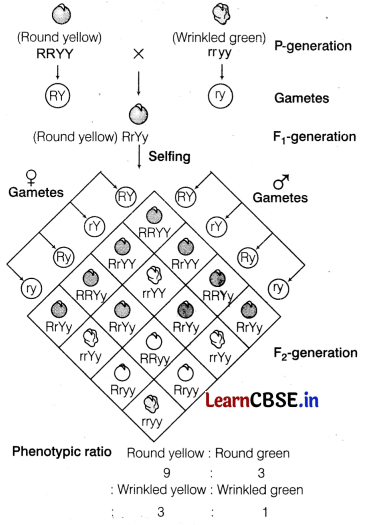
These factors randomly rearrange in the offspring producing both parental and new combination of characters. It means inheritance of one character does not affect the inheritance of another character and both characters assort independently during gamete formation. The Punnett square can be used to understand the independent segregation of the two pairs of genes during meiosis.
Question 59.
(i) What is polygenic inheritance? Explain with the help of a suitable example.
(ii) How &re pleiotropy and Mendelian pattern of inheritance different from polygenic pattern of inheritance? (All India 2016)
Answer:
(i) Polygenic Inheritance It was proposed by Galton in 1833 and he suggested that many instances of continuous variations are heritable. In this case, a trait is controlled by three or more genes and the graded phenotypes develop due to the additive or cumulative effect of all the different genes of the trait, e.g. human skin colour, height, intelligence etc.
Polygene is a gene where one dominant allele controls only a unit or partial quantitative expression of a trait.
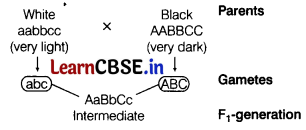
It also takes into account the influence of environment and is also called as quantitative inheritance, as the character or phenotype can be quantified, like the amount of pigment, intelligence in human beings and milk yield in animals. These characters have been found to be determined by many genes and their effects have been cumulative. These traits are called polygenic traits, e.g. human skin colour explains the phenomenon of polygenic inheritance. Skin colour in human is produced by a pigment called melanin. The quantity of melanin is due to three pairs of polygenes (A, B and C). If black or very dark (AABBCC) and white or very light (aabbcc) individuals marry each other, the offsprings or individuals of F,-generation show intermediate colour which are often called mulatto (AaBbCc).
A total of eight allele combinations are possible in the gametes forming 27 distinct genotypes distributed into 7 phenotypes, i.e. 1 very dark, 6 dark, 15 fairly dark, 20 intermediate, 15 fairly light, 6 light and 1 very light.
(ii) In pleiotropy, single gene product may produce multiple or more than one phenotypic effect whereas in polygenic inheritance single phenotypic trait (human skin colour) is controlled by 3 pairs of genes (A, B and C). In Mendelian inheritance, one gene controls one phenotypic character (flower colour red or white). However, in polygenic inheritnace one phenotype is controlled by more than one gene.
Question 60.
(i) A couple with blood group A and B, respectively have a child with blood group O. Work out a cross to show how it is possible and the probable blood groups that can be expected in their other offspring.
(ii) Explain the genetic basis of blood groups in human population. (All India 2015C, Delhi 2015)
Answer:
(i) Parents must be heterozygous since blood group ‘O’ appears in progeny. The progeny can have all the four blood groups. A, B, AB and O. There are three alleles of the gene controlling blood group character, i.e. I
A
, I
B
and i. I
A
and I
B
are dominant over i and together they are codominant to each other.
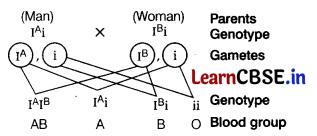
(ii) ABO blood grouping in humans shows the phenomenon of codominance. Refer to Answer No. 29 and 47.
Question 61.
(i) State and explain the law of segregation as proposed by Mendel in a monohybrid cross.
(ii) Write the Mendelian F
2
phenotypic ratio in a dihybrid cross. State the law that he proposed on the basis of this ratio. How is this law different from the law of segregation? Foreign 2015
Answer:
(i) Law of segregation states that the factors or alleles of a pair segregate from each other during gamete formation in a way that a gamete receives only one of the two factors. They do not show any blending. The pattern of inheritance can be understood by crossing F
1
-hybrid (Tt heterozygous) of a tall plant with a dwarf plant.
Here, hybrid tall makes two types of gametes (T) and (t), while pure dwarf makes only one type of gamete, i.e. (t). It is because only one allele can enter in a gamete for a character.
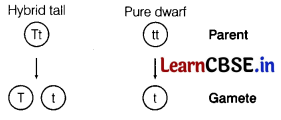
(ii) (a) Mendelian F
2
phenotypic ratio in a dihybrid cross is 9 : 3 : 3 : 1.
(b) Law of independent assortment was proposed on the basis of dihybrid cross. It states that when two pairs of contrasting traits are combined in a hybrid, segregation of one pair of characters is independent of the other pair of characters.
Differences between law of segregation and law of independent assortment are:
| Law of segregation | Law of independent assortment |
| It is based on the monohybrid cross. | It is based on the dihybrid cross. |
| It explains non-mixing of two alleles of a gene at the time of gamete formation. | It explains non-mixing of characters during their inheritance to the next generation. |
Question 62.
Give a genetic explanation for the following cross. When a tall pea plant with round seeds was crossed with a dwarf pea plant with wrinkled seeds then all the individuals of F
1
-population were tall with round seeds. However, selfing among F
1
population led to a 9 : 3 : 3 : 1 phenotypic ratio. (All India 2015)
Answer:
The cross given in the question is a dihybrid cross, which explains the third law of Mendel, i.e. law of independent assortment. In a dihybrid cross inheritance pattern of two traits are considered simultaneously.
This law states that when two pairs of traits are combined in a hybrid, segregation of one pair of character is independent of the other pair of characters at the time of gamete formation. The alleles controlling these characters also get randomly rearranged in the offspring producing both parental and new combinations of characters.
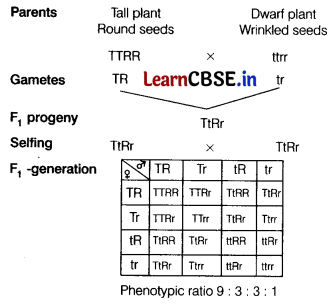
The ratio 9 : 3 : 3 : 1 was. obtained because the factors of height of plant and those for shape of seeds have segregated independently and each gamete has one factor for each of these two traits.
Question 63.
A cross was carried out between a pea plant heterozygous for round and yellow seeds with a pea plant having wrinkled and green seeds.
(i) Show the cross in a Punnett square.
(ii) Write the phenotype of the progeny of this cross.
(iii) What is this cross known as? State the purpose of conducting such a cross. (All India 2014C; Foreign 2014)
Answer:
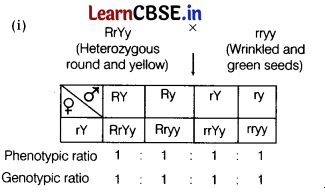
(ii) Phenotypic ratio Round yellow : Round green : Wrinkled yellow : Wrinkled green = 1 : 1 : 1 : 1
Genotypic ratio 1 : 1 : 1 : 1
(iii) This cross is known as dihybrid test cross. The purpose of this cross is to determine the relationship between different allelic pairs.
Question 64.
Work out a monohybrid cross up to F
1
-generation between two pea plants and two Antirrhinum plants both having contrasting traits with respect to colour of flower. Comment on the pattern of inheritance in the crosses carried above. (All India 2014C)
Answer:
Refer to Answer No. 53 for cross showing inheritance pattern of flower colour in garden pea plant.
Phenotypic ratio
Purple : White
3 : 1
Genotypic ratio
PP : Pp : pp
1 : 2 : 1
Inheritance of flower colour in garden pea shows true dominance. In F
1
-generation, dominant colour purple is expressed and in F
2
-generation, both dominant (purple) and recessive (white) colours are expressed in the ratio of 3 : 1.
Inheritance pattern of flower colour in Antirrhium (snapdragon), Refer to Answer No. 24. Inheritance in snapdragon flower colour shows incomplete dominance. In this phenomenon, neither of the two alleles is completely dominant over the other and the hybrid is intermediate between the two. Hence, red is homozygous dominant, white is homozygous recessive, while hybrid is intermediate, i.e. pink.
![]()
Question 65.
(i) Differentiate between dominance and co-dominance.
(ii) Explain codominance taking an example of human blood groups in the population. (All India 2013)
Answer:
(i) Difference between dominance and codominance is as follows
Dominance:
Out of the two contrasting alleles of a gene, only one can produce effect in heterozygous condition, e.g. trait of tallness in pea plants.
Codominance:
Both the alternative forms of a gene can produce effect in heterozygous condition, e.g. ABO blood grouping in humans.
(ii) Refer to Answer No. 47.
Question 66.
(i) Explain Mendel’s law of independent assortment by taking a suitable example.
(ii) How did Morgan show the deviation in inheritance pattern in Drosophila with respect to this law? (All India 2013)
Answer:
(i) Refer to Answer No. 58.
(ii) Morgan found that linkage is an exception to the law of independent assortment.
Conclusion of Morgan’s studies, Refer to Answer No. 49.
Question 67.
What is the inheritance pattern observed in the size of starch grains and seed shape of Pisum sativum. Work out the monohybrid cross showing the above traits. How does this pattern of inheritance deviate from that of Mendelian law of dominance? (Delhi 2013)
Or
Pea seeds with BB alleles have round seeds and large starch grains, while seeds with bb alleles have wrinkled seeds with small starch grains.
Work out the cross between these two parents. Explain the phenotypic ratio of the progeny with respect to seed shape and the starch grain size of the progeny produced. (All India 2012C)
Answer:
The starch synthesis in pea plants is controlled by a single gene. It has two alleles B and b. BB homozygotes produce large starch grains as compared to that produced by bb homozygotes.
After maturation, it was observed that BB seeds were round and bb were wrinkled. When they were crossed, the resultant progeny have intermediate sized (Bb) seeds.
The cross involved is
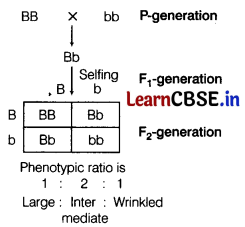
Deviation from Mendel’s law of dominance: If starch grain size is considered as the phenotype, then, the alleles show incomplete dominance.
Thus, dominance is not an autonomous feature of a gene, it depends on gene product and production of particular phenotype from this product.
Question 68.
Differentiate between the following.
(i) Polygenic inheritance and pleiotropy.
(ii) Dominance, codominance and incomplete dominance. (All India 2013C; Delhi 2011)
Answer:
(i) Differences between polygenic inheritance and. pleiotropy are as follows
| Polygenic inheritance | Pleiotropy |
| Single phenotypic effect is under the control of many genes. | Single gene product confers many phenotypic effects. |
| The genes involved are called polygenes, e.g. human skin colour. | The genes involved are called pleiotropic genes. eg-phenylketonuria. |
(ii) Differences between dominance, codominance and incomplete dominance are as follows
| Dominance | Codominance | Incomplete dominance |
| It is a relationship between alleles of a single gene, in which one allele masks the phenotypic expression of another allele at the same gene locus, e.g. tallness in pea plant. | It is the phenomenon of expression of both the alleles in heterozygous condition. In this, alleles do not show dominant-recessive relationship and are able to express themselves independently, e.g. ABO blood group in humans. | It is also known as partial or mosaic dominance where none of the two contrasting alleles or factors is dominant, e.g. incomplete dominance in 4 ‘O’ clock plant. |
Incomplete dominance
It is also known as partial or mosaic dominance where none of the two contrasting alleles or factors is dominant, e.g. incomplete dominance in 4 ‘O’ clock plant.
Question 69.
(i) List three different allelic forms of gene T in human. Explain the different phenotypic expressions, controlled by these three forms.
(ii) A woman with blood group A marries a man with blood group O. Discuss the possibilities of the inheritance of the blood group in the following starting with ‘yes’ or ‘no’ for each.
(a) They produce children with blood group A only.
(b) They produce children, some with 0 blood group and some with A blood group. (Delhi 2012)
Answer:
(i) In humans, the ABO blood groups are controlled by a gene called T. It has three alleles. These are I
A
, I
B
and i.
Table showing the genetic basic of blood groups in human population Refer to Answer No. 47.
(ii) (a) No, its not necessary as mother could have a genotype I A I A or I A i. If the genotype is I A I A , all the offsprings would have A blood group, but in the second case, offsprings can have either ‘A’ or ‘O’ blood group as their father has ‘O’ blood group.
(b) Yes, if the mother is of genotype I A i and father is ‘O’ (genotype ii), blood group of some children can be ‘O’ and some can be ‘A’.
Question 70.
(i) Explain monohybrid cross taking seed coat colour as a trait in Pisum sativum. Work out the cross up to F
2
-generation.
(ii) State the law of inheritance that can be derived from such a cross.
(iii) How is the phenotypic ratio of F
2
-generation different in a dihybrid cross? (All India 2012)
Answer:
(i) In a monohybrid cross, when homozygous dominant and homozygous recessive parents are crossed, F
1
-hybrid would be heterozygous for the trait and would express the dominant allele.
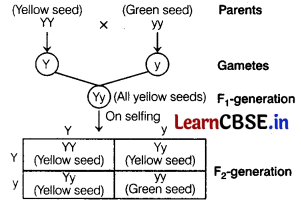
(ii) The laws of inheritance that can be derived from such a cross are
(a) Law of dominance
(b) Law of segregation
(iii) Phenotypic ratio in F
2
-generation.
In monohybrid cross – 3:1
In dihybrid cross – 9 : 3 : 3 : 1
Question 71.
When a garden pea plant with violet flowers was crossed with another plant with white flowers, 50% of the progeny bear violet flowers.
(i) Work out the cross.
(ii) Name the type of cross and mention its significance.
(iii) How does the inheritance pattern of flower colour in snapdragon differ from the above? (Delhi 2010c)
Or
When a garden pea plant with green pods was cross-pollinated with another plant with yellow pods, 50% of the progeny borne green pods.
(i) Work out the cross to illustrate this.
(ii) How do you refer to this type of cross? Why is such a cross done? (All India 2010C)
Answer:
(i) The test cross ratio is 1 : 1.
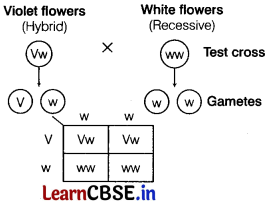
50% flowers are violet. The dominant plant is heterozygous, i.e. Vw. On crossing with white flowers, 50% dominant violet colour is expressed.
(ii) Type of cross-Test cross. Significance The cross is used to determine the genotype of the unknown dominant parent.
(iii) In this test cross, violet and pure white flowers when crossed produce violet and white flowers.
Whereas in snapdragon, the F
1
-generation hybrid was pink coloured. F
2
-generation consists of red, pink and white flowers in the ratio of 1 red : 2 pink : 1 white. This is due to incomplete dominance. Similar type of cross can be made for plants with green and yellow pods.
Question 72.
Write the sex of a human having XXY chromosome With 22 pairs of autosomes. Name the disorder this human suffers from. (2018C)
Answer:
The sex of a human having XXY chromosomeswith 22 pairs of autosomes is male.
The disorder from which this human is suffering is Klinefelter’s syndrome.
Question 73.
State the fate of a pair of autosome during gamete formation. (Delhi 2017)
Answer:
During gamete formation, the homologous pair of autosomes gets separated from each other and moves to different gametes, so that each gamete receives haploid set of chromosomes.
Question 74.
Give an example of a human disorder that is caused due to a single gene mutation. (Delhi 2016)
Answer:
Sickle-cell anaemia is an example of a human disorder that is an caused due to a single gene mutation.
Question 75.
Give an example of a sex-linked recessive disorder in humans. (Delhi 2016C)
Answer:
Haemophilia is a sex-linked recessive disorder in humans.
Question 76.
Give an example of an organism that exhibits haplo-diploidy sex-determination system. (Delhi 2016)
Answer:
Haplo-diploidy sex-determination system is seen in honeybees.
Question 77.
Give one example of organism exhibiting female heterogamety. (Outside Delhi 2016C)
Or
Write the chromosomal basis of sex-determination in birds. (Delhi 2016C)
Or
Explain the mechanism of sex-determination in birds. (Delhi 2015)
Answer:
Female heterogamety is exhibited by birds. They have ZW-ZZ type of sex-determination mechanism. In this type, the male is homogametic and the female is heterogametic. Therefore, there are two types of eggs, i.e. with Z and with W and only one type of sperms, i.e. each with Z.
When egg with Z-chromosome is fertilised by a sperm with Z-chromosome, a zygote with ZZ-chromosomes (male) is formed. Similarly when egg with W-chromosome is fertilised by a sperm with Z-chromosome, a zygote with ZW-chromosomes (female) is formed.
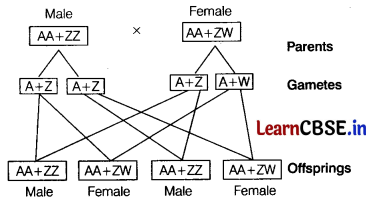
Question 78.
Identify the correct statement
(i) Females of many birds have a pair of dissimilar ZW-chromosomes, while the males possess a pair of similar 2Z-chromosomes.
(ii) Females of many birds have a pair of similar ZZ-chromosomes, while the males possess a pair of dissimilar ZW-chromosomes. (All India 2014C)
Answer:
The correct statement is
(i) Females of many birds have a pair of dissimilar ZW-chromosomes, while the males possess a pair of similar ZZ-chromosomes.
![]()
Question 79.
Identify and write the correct statement
(i) In grasshopper males, two sex chromosomes are X and Y type.
(ii) In grasshopper males, there exist XO type of sex-determinants. (All India 2014C)
Answer:
The correct statement Is
(ii) In grasshopper males, there exist XO type of sex-determinants.
Question 80.
Identify and write the correct statement
(i) Drosophila male has one X and one Y-chromosome.
(ii) Drosophila male has two X-chromosomes. (All India 2014C)
Answer:
The correct statement is
(i) Drosophila male has one X and one Y-chromosome.
Question 81.
Why do normal red blood cells become
elongated and sickle-shaped in structure in a person suffering from sickle-cell anaemia? (Foreign 2014)
Answer:
In sickle-cell anaemia, substitution of valine in place of glutamic acid in the sixth position of haemoglobin chain occurs. The mutant haemoglobin molecule undergoes polymerisation under low oxygen tension causing the change in the shape of the RBC from biconcave disc to the elongated sickle-like structure.
Question 82.
Name one autosomal dominant and one autosomal recessive Mendelian disorder in humans. (All India 2010)
Answer:
Autosomal dominant Mendelian disorder- Huntington’s disease.
Autosomal recessive Mendelian disorder-Sickle-cell anaemia.
Question 83.
Write the genotype of
(i) an individual who is the carrier of sickle-cell anaemia gene, but apparently unaffected and
(ii) an individual affected with the disease. (All India 2010)
Answer:
(i) Hb
A
Hb
s
(ii) Hb
s
Hb
s
Question 84.
A human being suffering from Down’s syndrome shows trisomy of 21st chromosome. Mention the cause of this chromosomal abnormality. (All India 2010)
Or
Write the cause of Down’s syndrome in humans. (All India 2010C)
Answer:
This is due to non-disjunction, i.e. failure of segregation of homologous chromosomes during gamete formation resulting in the gain of an extra copy of chromosome number 21 (21 Trisomy).
Question 85.
The son of a haemophilic man may not get this genetic disorder. Mention the reason. (Delhi 2010C)
Answer:
The gene responsible for haemophilia is located on X-chromosome and males have only single copy of X-chromosome with no alternate normal allele. The son gets X-chromosome from mother only. So, if the female is normal, the son may not get this genetic disorder from male (father).
Question 86.
Write the genotypes of the parents of a child suffering from thalassemia. State the cause of this disease. (All India 2019)
Answer:
The genotypes of the parents of a child suffering from thalassemia are as follows
Mother → Th
B
Th
B+
Father → Th
B
Th
B+
Thalassemia is an autosomal-linked recessive disease, which results in reduced rate of synthesis of one of the globin chains of haemoglobin. The disease is controlled by a single pair of allele, Th
B
and Th
B+
. Th
B
codes for normal B-protein and Th
B+
codes for an abnormal B-protein. Only homozygous individuals for Th
B+
(Th
B+
Th
B+
) show the diseased phenotype.
Question 87.
Name a disorder a human suffers from as a result of monosomy of the sex chromosome. Give the karyotype and write the symptoms. (All India 2019)
Answer:
Monosomy of the sex chromosome in humans results in Turner’s syndrome.
The number of chromosomes is 45 (44+ XO).
Symptoms are as follows:
- The affected females are sterile as ovaries are rudimentary.
- Other symptoms include lack of secondary sexual characters, short stature, etc
Question 88.
A haemophilic father can never pass the gene for haemophilia to his son. Explain. (2018)
Or
A cross between a normal couple resulted in a son who was haemophilic and a normal daughter. In course of time, when the daughter was married to a normal man, to their surprise, the grandson was also haemophilic.
(i) Represent this cross in the form of a pedigree chart. Give the genotypes of the daughter and her husband.
(ii) Write the conclusion you draw from the inheritance pattern of this disease. (Delhi 2014)
Answer:
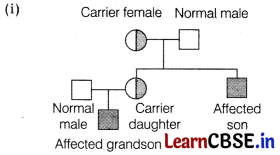
Genotypes of daughter and her husband are X
h
X and XY, respectively.
(ii) Haemophilia is a sex-linked recessive disease. It is transmitted from the carrier female to her sons. From the above pedigree chart, it can be observed that the disease is being transmitted from the carrier female to her daughter (carrier) and son (affected). The carrier daughter transmits this disease to the grandson. This pattern of inheritance is called criss-cross inheritance.
Question 89.
Is haemophilia in humans a sex-linked or autosomal disorder? Work out a cross in support of your answer. (Outside Delhi 2016C)
Answer:
Haemophilia is a sex-linked disorder and more specifically it is X-linked disorder.
If normal parents give rise to a haemophilic child, then their genotypes should be
Father – XY (normal)
Mother – XX
h
(carrier/heterozygous non-haemophilic)
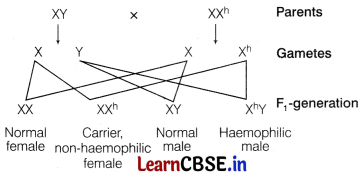
Question 90.
A couple with normal vision bears a colourblind child. Work out the cross to show how it is possible and mention the sex of the affected child. (Delhi 2016)
Or
A colourblind child is born to a normal couple. Work out a cross to show how it is possible. Mention the sex of this child. (Delhi 2014)
Answer:
Colour blindness is a sex-linked disease which results in the defect in either red or green cone cells of eyes. The gene for this disorder is present on the X-chromosome. Hence, it is carried by normal females that do not express the disease.
If a colourblind child is born to a normal couple, then the mother would be the carrier of the disease. The following cross shows the inheritance of the disorder
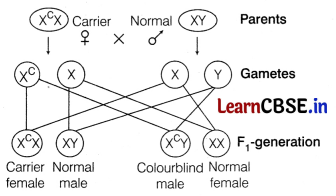
Thus, the sex of colourblind child would be male.
Question 91.
Differentiate between male and female heterogamety. (Delhi 2015)
Answer:
Differences between male and female heterogamety are
| Male heterogamety | Female heterogamety |
| Male produces two different types of gametes. | Female produces two different types of gametes. |
| Example: human male produces gametes with either X or Y-chromosomes. | Example: female birds produce gametes with either Z or W type chromosomes. |
Question 92.
Why is the possibility of a human female suffering from haemophilia rare? Explain. (Foreign 2014, All India 2012,2013,2014C)
Answer:
Haemophilia is an X-linked recessive disease. Therefore, the females having haemophilic allele on single X-chromosome do not produce haemophilic phenotype. Females suffer from this disease only if the father is haemophilic and the mother is at least the carrier of disease. Such condition is rare and hence, the human females are rarely haemophilic.
Question 93.
Why is pedigree analysis done in the study of human genetics? State the conclusions that can be drawn from it. (All India 2014)
Answer:
The study of inheritance of genetic traits in several generations of a human family in the form of a family diagram is called pedigree analysis. Inheritance pattern of traits in human beings cannot be studied by crosses. Thus, pedigree analysis is done. Based on the pedigree studies, inheritance of a specific trait, abnormality or disease can be traced.
Question 94.
Identify a, b, c, d, e and / in the table given below (All India 2014)
| Syndrome | Cause | Characteristics of affected individual | Sex Male/ Female/ Both |
| Down’s | Trisomy of 21 | a (i), (ii) | b |
| c | XXY | Overall masculine development | d |
| Turner’s | 45 with XO | e (i) (ii) | f |
Answer:
(a) (i) Short stature individuals with round head and furrowed tongue.
(ii) Slow piental development.
(b) Both
(c) Klinefelter’s syndrome
(d) Male
(e) (i) Rudimentary ovaries.
(ii) Lack of secondary sexual characters.
(f) Female
Question 95.
Women are often blamed for producing female children. Consequently, they are ill-treated and ostracised. How will you address this issue scientifically, if you were to conduct an awareness programme to highlight the values involved? (Delhi 2014)
Or
Explain why it is scientifically incorrect to blame the mother for bearing a female child? (Delhi 2013C)
Or
Do you agree to the perception in our society that the woman is responsible for the gender? Substantiate your answer scientifically. (All India 2011C)
Answer:
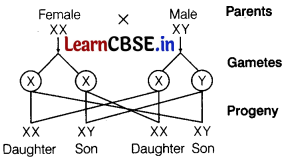
Question 96.
Name a blood related autosomal Mendelian disorder. Why is it called Mendelian disorder? How is the disorder transmitted from parents to offspring? (All India 2014C)
Answer:
A blood related autosomal Mendelian genetic disorder is sickle-cell anaemia. It occurs by the change of a single base pair in the gene, leading to the substitution of glutamic acid by valine at the 6th position of p-globin chain of haemoglobin.
Since, its transmission follows Mendelian principles, it is called Mendelian disorder. Inheritance pattern It is transmitted from parents to the offspring, when both the partners are carriers (heterozygous) of the disease.
Refer to the cross on page no. 116.
Question 97.
Write the types of sex-determination mechanisms the following crosses show. Give an example of each type.
(i) Female XX with male XO.
(ii) Female ZW with male ZZ. (Delhi 2014)
Answer:
(i) The type of sex-determination mechanism shown in female XX and males XO is called male heterogamety. In this case, males are heterogametic with half of the male gametes carrying X-chromosome while the other half being devoid of it, e.g. grasshopper.
(ii) The type of sex-determination mechanism is female heterogamety because female produces two different types of gametes, i.e. Z and W while males are ZZ type, e.g. birds.
Question 98.
(i) Colour blindness in humans is a sex-linked trait. Explain with the help of a cross.
(ii) In human beings, the sex of the child is determined by the father and not by the mother. Explain. (All India 2014C)
Answer:
(i) Refer to Answer No. 19.
(ii) Refer to Answer No. 24. (1+1)
Question 99.

This is the pedigree of a family tracing the movement of the gene for haemophilia. Explain the pattern of inheritance of the disease in the family. (Delhi 2013C)
Or
Haemophilia is a sex-linked inheritance condition in humans where a simple cut causes non-stop bleeding. Study the pedigree chart showing the inheritance of haemophilia in a family. Answer the questions that follows
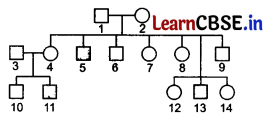
Give reasons, which explain that haemophilia is (Foreign 2011)
(i) sex-linked (ii) caused by X-linked gene.
Answer:
The pedigree of a family given in the question depicts that mother is normal (XX), while father is haemophilic (X
h
Y). As haemophilia is a sex-linked disease, F
1
-generation will produce 50% carrier daughters and 50% normal sons. In F
2
-generation, both carrier daughters got married to a normal man and produced 25% diseased (X
h
Y) and 25% normal son (XY) and 25% carrier (X
C
X) and 25% normal daughter (XX).
Or
(i) (a) It is X-linked trait which is transmitted from an unaffected carrier female to some of the male offsprings.
(b) Females rarely become haemophilic as in this cases, the mother has to be at least a carrier and father should be haemophilic.
(ii) Gene for haemophilia is X-linked or present on X-chromosome because male receives this gene from mother.
(a) So, a carrier female transmits it to her son.
(b) Disease appears more in males because they have only one X-chromosome.
![]()
Question 100.
A relevant portion of (3-chain of haemoglobin of a normal person is given below

The codon for the sixth amino acid is GAG. The sixth codon GAG mutates to GAA as a result of mutation ‘A’ and to GUG as a result of mutation ‘B’. Haemoglobin structure did not change as a result of mutation ‘A’, whereas haemoglobin structure changed because of mutation ‘B’ leading to sickle-shaped RBCs.
Explain giving reasons how. could mutation ‘B’ lead to sickle-shaped RBCs. Explain giving reasons how could mutation.‘B’ change the haemoglobin structure or bring down mutation and not mutation ‘A’. (All India 2011)
Answer:
In mutation A, the change in amino acid does not occur when codon GAG changes to GAA because both GAG and GAA code for amino acid, glutamic acid. Thus, there is no change in haemoglobin structure.
In mutation B, the change in amino acid occurs when codon GAG is changed to GUG because GUG codes for valine, while the original codon GAG codes for glutamic acid. Thus, there will be a change in the haemoglobin structure which would lead to sickle-cell anaemia.
Question 101.
Given below is the representation of a relevant part of amino acid composition of the ß-chain of haemoglobin, related to the shape of human red blood cells.
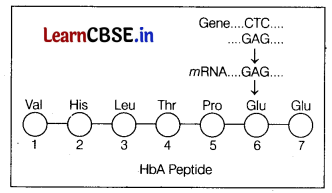
(i) Is this representation of the sequence of amino acids indicating a normal human or a sufferer from a certain blood related genetic disease? Give reason in support of your answer.
(ii) Why is the disease referred to as a Mendelian disorder? Explain. (All India 2019)
Or
Given below is the representation of amino acid composition of the relevant translated portion of ß-chain of haemoglobin, related to the shape of human red blood cells.
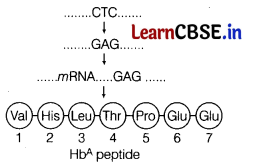
(i) Is this representation indicating a normal human or a sufferer from certain related genetic disease? Give reason in support of your answer.
(ii) What difference would be noticed in the phenotype of the normal and the sufferer related to this gene?
(iii) Who are likely to suffer more from the defect related to the gene represented the males, the females or both males and females equally? And why? (Delhi 2012)
Answer:
(i) This representation indicates normal human because normal peptide Hb
A
is with glutamic acid (Glu) at sixth position of (1-globin chain of haemoglobin molecule. Sickle-cell anaemia is referred to as Mendelian disorder because each parent contributes one mutant allele to affected offspring and the recessive sickle trait is expressed in homozygous condition only.
(ii) The normal individual has biconcave, disc-like RBCs, whereas the sufferer has sickle-shaped RBCs.
(iii) It is an autosomal recessive disorder. So, both males and females suffer equally.
Question 102.
Name the kind of diseases/disorders and any two symptoms that are likely to occur in humans if
(i) Mutation in the gene that codes for an enzyme phenylalanine hydroxylase occurs.
(ii) the karyotype is XXY. (All India 2019)
Or
(i) Name the kind of diseases/disorders that are likely to occur in humans if
(a) mutation in the gene that codes for an enzyme phenylalanine hydrolase occurs,
(b) there is an extra copy of chromosome 21,
(c) the karyotype is XXY.
(ii) Mention any one symptom of the diseases/disorders named above. (Foreign 2015)
Answer:
(i) The following types of diseases are likely to occur in human
(a) Phenylketonuria
(b) Down’s syndrome
(c) Klinefelter’s syndrome
(ii) Symptoms of above diseases are
(a) Phenylketonuria Accumulation of phenylketonuria causes mental retardation.
(b) Down’s syndrome Affected individuals are short statured with small round head.
(c) Klinefelter’s syndrome The individuals are sterile.
Question 103.
Explain the mechanism of sex-determination in birds. How does it differ from that of human beings? 2018
Or
Differentiate between ‘ZZ’ and ‘XT type of sex-determination mechanisms. (Delhi 2015)
Or
Explain the sex-determination mechanism in humans. How is it different in birds? (All India 2010)
Answer:
Differences between XY and ZZ types of sex-determination are as follows
|
XY type sex-determination
(In humans) |
ZZ type sex-determination
(In birds) |
| Females are homogametic, while males are heterogametic. | Females are heterogametic, while males are homogametic. |
|
Female produces egg with X-chromosomes only, while male produces sperms with either X or Y-chromosomes
Example: humans, Drosophila |
Female produces eggs with either Z or W-chromosomes, while male produces sperm with Z-chromosomes.
Example: fish, birds, etc. |
Sex-determination in humans Refer to Answer No. 24.
Sex-determination in birds Refer to Answer No. 6.
Question 104.
During a medical investigation, an infant was found to possess an extra chromosome 21. Describe the symptoms the child is likely to develop later in the life. (Delhi 2017)
Or
Explain how trisomy of 21st chromosome occurs in humans. List any four characteristic features in an individual suffering from it. (Foreign 2012)
Or
Name the genetic disorder caused by trisomy of 21st chromosome in a human. Write the diagnostic features of the disorder. (Delhi 2011C)
Answer:
An additional copy of chromosome number 21 (trisomy of chromosome number 21) in humans results in Down’s syndrome.
Following characteristic symptoms are likely to develop in the child suffering from Down’s syndrome
- Short statured with small, round head.
- Furrowed tongue and partially open mouth.
- Broad palm with characteristics palm crease.
- Slow mental, physical and psychomotor development.
Question 105.
Both haemophilia and thalassemia are blood related disorders in humans. Write their causes and the difference between the two. Name the category of genetic disorder they both come under. (All India 2017)
Answer:
Haemophilia and thalassemia both are Mendelian or gene related human disorders.
Cause of Haemophilia It is caused due to the absence of antihaemophilic globulin and plasma thromboplastin factor.
Cause of Thalassemia It is caused due to mutation or deletion of the genes controlling the formation of globin chains (a and P) of haemoglobin.
Differences between haemophilia and thalassemia are as follows
| Haemophilia | Thalassemia |
| Influence on single trait. | Influence on multiple traits. |
| Inheritance is criss-cross. | Inheritance is straight from both the parents to all the offsprings. |
Category of genetic disorder
Haemophilia – Sex-linked disease
Thalassemia – Autosomal recessive disease
Question 106.
Give the example of an autosomal recessive trait in humans. Explain its pattern of inheritance with the help of a cross. (Delhi 2016)
Answer:
Sickle-cell anaemia is an autosomal recessive trait in humans. Refer to Answer No. 25 for detail. The inheritance of sickle-cell anaemia is shown in the cross given below
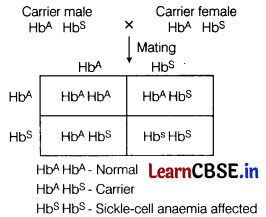
Question 107.
Which chromosomes carry the mutant genes causing thalassemia in humans? What are the problems caused by these mutant genes? (Delhi 2015)
Or
Write the type and location of the gene causing thalassemia in humans. State the cause and symptoms of the disease. How is sickle-cell anaemia different from this disease? (Foreign 2014)
Answer:
Thalassemia is an autosomal-linked recessive disease, which occurs due to either mutation or deletion of genes, resulting in reduced rate of synthesis of one of the globin chains of haemoglobin. It is associated with the mutation in chromosome 11 or 16 which code for p-chain and a – chain of haemoglobin, respectively. Haemoglobin is the oxygen carrying component of the red blood cells. It consists of two different proteins, an a and a p. If the body does not produce enough of either of these two proteins, the red blood cells do not form properly and cannot carry sufficient oxygen.
This results in anaemia that begins in early childhood and lasts throughout the life.
For sickle-cell anaemia, Refer to Answer No. 25.
Question 108.
Name the phenomenon that leads to situations like ‘XO’ abnormality in humans. How do humans with ‘XO’ abnormality suffer? Explain. (Foreign 2012)
Or
Name a disorder, give the karyotype and write the symptoms a human suffers from as a result of monosomy of the sex chromosome. (Foreign 2011)
Or
(i) Name the genetic disorder in a human female having 44 + XO karyotype. Mention the diagnostic features of this disorder.
(ii) Explain the cause of such chromosomal disorder. (Delhi 2011c)
Answer:
XO abnormality or monosomy of
X-chromosome represents chromosomal disorder called Turner’s syndrome.
Non-disjunction is responsible for this chromosomal disorder. It is the phenomenon of failure of segregation of the members of homologous pairs of the chromosomes. Such disorder occurs due to the absence of one X-chromosome, i.e. 45 with XO (karyotype). The affected individual has underdeveloped feminine characters. Females are sterile and ovaries are rudimentary.
Question 109.
(i) Sickle-cell anaemia in humans is a result of point mutation. Explain.
(ii) Write the genotypes of both the parents, who have produced a sickle-celled anaemic offspring. (Delhi 2011)
Answer:
(i) Point mutation occurs due to change in a single base pair of DNA. Sickle-cell anaemia occurs due to defect caused by the single base substitution at the sixth codon of the P-chain of haemoglobin from GAG to GUG.
This causes substitution of glutamic acid by valine. The defective haemoglobin molecule undergoes polymerisation under low oxygen tension causing sickle-shaped red blood cells.
(ii) The parents must be heterozygotes, i.e. Hb A Hb s and Hb A Hb s to produce a sickle-celled anaemic offspring. Refer to Answer No. 25 and 35.
Question 110.
Name a disorder, give the karyotype and write the symptoms where a human male suffers as a result of an additional X-chromosome. (Foreign 2011)
Or
Name the genetic disorder caused by an extra X-chromosome in a human male. State the diagnostic features of the individual suffering from it. (Delhi 2011C)
Answer:
It is a chromosomal disorder called Klinefelter’s syndrome, which occurs in males. The affected human males have XXY sex chromosome (47 chromosomes).
Karyotype: 44 + XY
Symptoms
- Development of feminine characters like breast development.
- Body hair sparse.
- Individual is sterile.
Question 111.
(i) Why are grasshopper and Drosophila said to show male heterogamety? Explain.
(ii) Explain female heterogamety with the help of an example. (All India 2010)
Or
Explain the mechanism of sex-determination in insects like Drosophila and grasshopper. (All India 2010)
Answer:
(i) In male heterogamety, males produce two different types of gametes. In humans and Drosophila, the males have one X and Y chromosome, whereas in grasshopper, the male have only one X-chromosome (XO type). Thus, the males of these organisms show male heterogamety as they produce two types of gametes
Either with or without X-chromosome
Some gametes with X-chromosome and some with Y-chromosome.
(ii) In some organisms, females produce two different types of gametes. This is termed as female heterogamety. In birds and some reptiles, female has two different sex chromosomes (one Z and one W-chromosome) whereas male has a pair of same chromosome (a pair of Z-chromosome). (11/2)
Question 112.
(i) Why are thalassemia and haemophilia categorised as Mendelian disorders? Write the symptoms of these diseases. Explain their pattern of inheritance in humans.
(ii) Write the genotypes of the normal parents producing a haemophilic son. (All India 2015)
Answer:
(i) Thalassemia and haemophilia are categorised as Mendelian disorders because these disorders are due to alteration in a single gene. Also, they are transmitted to offspring through Mendelian principles of inheritance.
Symptoms and pattern of inheritance are given below
(a) Thalassemia It is an autosome-linked recessive blood disorder characterised by defect in α, ß or δ-chain resulting in abnormal Hb molecule.
Symptom Anaemia: Inheritance Two mutant alleles (one from each parent) must be inherited for an individual to be affected, i.e. homozygous. Heterozygous are carriers and may pass the mutant allele to their children.
(b) Haemophilia It is a sex-linked recessive disorder whose gene is located on X-chromosome.
Symptom Prolonged clotting time and internal bleeding, even in a minor injury.
Inheritance The gene is present on X-chromosome, so it is inherited by males as they have a single X-chromosome. Affected males are said to be hemizygous. Females have 2 X-chromosomes, thus their possibility of being affected is rare as the mother of such female has to be at least carrier and father should be haemophilic.
(ii) Genotypes of the normal parents producing a haemophilic son are X
C
X (carrier mother) and XY (father).
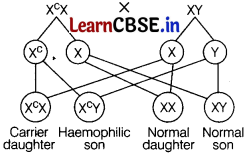
Question 113.
(i) Why are colour blindness and thalassemia categorised as Mendelian disorders? Write the symptoms of these diseases seen in people suffering from them.
(ii) About 8% of human male population suffers from colour blindness whereas only about 0.4% of human female population suffers from this disease. Write an explanation to show how it is possible. (All India 2015)
Answer:
(i) The inheritance pattern of colour blindness is same as that of haemophilia. Refer to Answer No. 41.
(ii) Colour blindness is an X-linked recessive trait which shows transmission from carrier female progeny. In males, the defect can appear in heterozygous condition beacause males possess only one X-chromosome whereas in females, it appears in homozygous condition only, which is very rare. Thus, it is more common in males than females.
![]()
Question 114.
(i) Explain the mechanism of sex-determination in humans.
(ii) Differentiate between male heterogamety and female heterogamety with the help of an example of each. (All India 2013)
Answer:
(i) Refer to Answer No. 24.
(ii) A sex (male or female) is heterogametic, if it has two different sex chromosomes.
Male heterogamety The female has two X-chromosomes (XX), while male has only one X-chromosome and at the time of gametogenesis the latter produces two types of gametes, 50% with X-chromosome, while other 50% without X-chromosomes. Heterogametic r tales are of two types
- XX-XY type, e.g. Drosophila, man, etc.
- XX-XO type, e.g. insects like grasshopper. Female heterogamety In some species like birds,’fishes, etc. females are heterogametic, i.e. produce two types of gametes, while males produce only one type of gamete.
Heterogametic females are of two types
- ZO-ZZ type, e.g. butterflies
- ZW-ZZ type, e.g. insects, fish, reptiles, birds, etc.
Question 115.
(i) Why is haemophilia generally observed in human males? Explain the conditions under which a human female can be haemophilic.
(ii) A pregnant human female was advised to undergo MTP. It was diagnosed by her doctor that the foetus she is carrying has developed from a zygote formed by an XX-egg fertilised by Y carrying sperm. Why was she advised to undergo MTP? (All India 2011)
Answer:
(i) The genes for haemophilia are present on X-chromosome. A male has only one X-chromosome and bears only one allele for the trait. He is hemizygous for the trait as Y-chromosome does not have a corresponding allele. A female contains two X-chromosomes. She has to be homozygous recessive to be haemophilic. It means her father must be a sufferer and mother must be either a carrier or sufferer to carry forward the disease.
(ii) The zygote will have XXY-chromosomes.
It will develop into a male with Klinefelter’s syndrome. Such males are sterile and show feminine characters. That is why, female was advised to undergo MTP.
Question 116.
(i) How does a chromosomal disorder differ from a Mendelian disorder?
(ii) Name any two chromosomal aberration-associated disorders.
(iii) List the characteristics of the disorders mentioned above that help in their diagnosis. (Delhi 2010)
Answer:
(i) Differences between chromosomal disorders and Mendelian disorders are
| Chromosomal disorders | Mendelian disorders |
| These are caused due to the absence or excess of one or more chromosomes or abnormal arrangement of one/more chromosomes. | These are due to alteration in a single gene. |
| They are not transmitted as the affected individual is sterile. | They are transmitted to generations through Mendelian principles of inheritance. |
| Example: Down’s syndrome, Turner’s syndrome. | Example: colour blindness, phenylketonuria. |
(ii) Chromosomal disorders Down’s syndrome and Klinefelter’s syndrome.
(iii) Down’s syndrome The affected individual is short statured with small round head, furrowed tongue and partially open mouth. Physical, psychomotor and mental development is also retarded.
Klinefelter’s syndrome It occurs in males, which show overall muscular development, but feminine development also occurs. Such individuals are sterile.
Question 117.
Explain the causes, inheritance pattern and symptoms of any two Mendelian genetic disorders. (Delhi 2010)
Answer:
Two Mendelian genetic disorders are as follows
- Sickle-cell anaemia Refer to Answer No. 25.
- Phenylketonuria It occurs due to defective allele on the autosome. It is inherited from parent, who are heterozygous for the gene to the offspring.
The affected individual lacks an enzyme phenylalanine hydroxylase that converts the amino acid phenylalanine into tyrosine. As a result, phenylalanine gets accumulated in brain and body and gets converted into phenyl pyruvate and other derivatives.
Symptoms Accumulation of these compounds in the brain causes mental retardation. They are also excreted in the urine due to poor absorption by kidney.
Question 118.
Study the given pedigree chart showing the pattern of blood group inheritance in a Family.
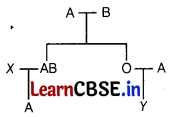
(i) Give the genotype of the following
(a) Parents
(b) The individual X in second generation.
(ii) State the possible blood groups of the individual Y in third generation.
(iii) Explain codominance with the inheritance of the blood group AB. (All India 2010C)
Answer:
(i) (a) Parents A – I
A
I
O
B- I
B
I
O
(b) Xindividual-I
B
I
O
(B-type)
(ii) Individual Y-blood groups can be O or A.
(iii) I
A
and I
B
when stay together, show the phenomenon of codominance and express themselves in the presence of each other.
In heterozygous hybrid, when both alternative alleles coexist, both the alleles show their effect and result in the progeny with AB blood group. This is called codominance.
Question 119.
Study the following pedigree chart of a family starting with mother with AB blood group and father with 0 blood group.
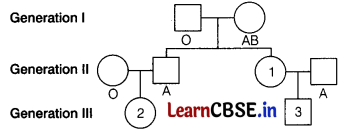
(i) Mention the blood group as well as its genotype of the offspring numbered 1 in generation II.
(ii) Write the possible blood groups as well as their genotypes of the offsprings numbered 2 and 3 in genearation III.
Answer:
(i) Offspring numbered 1 has blood group B with genotype I
O
I
B
.
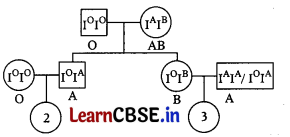
(ii) Offspring 2 may have blood group A (I
A
I
O
) or blood group O (I
O
I
O
).
There can be two cases for offspring numbered 3 to know the possible blood groups as well as their genotypes.
Case I When parent is homozygous for A, i.e. I
A
I
A
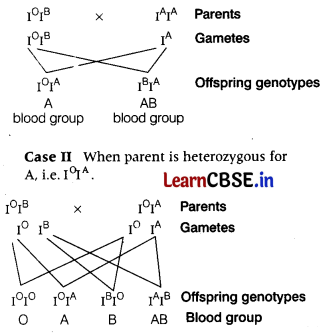
Question 120.
Naresh, a haemophilia patient, forbades his daughter to marry Mohan who is also a haemophilia patient. Is Naresh right?
Answer:
Naresh is right because his daughter can be carrier of haemophilia disease (an X-linked disorder).
If she marries a haemophilic person, there are 75% chances that their offspring will also suffer from haemophilia.
Question 121.
Avantika’e doctor advised her to undergo MTP because through diagnostic tests she came to know that her foetus has XO chromosomes. Do you think Avantika should undergo MTP? Give reason.
Answer:
(i) Yes, Avantika should undergo MTP.
(ii) The foetus contains XO chromosomes, i.e. one X-chromosome is lacking.
It means that the baby will be suffering from Turner’s syndrome. Therefore, MTP is recommended.
![]()
Question 122.
Prateek was rushed to a nearby hospital after an accident, which had caused too much blood loss. The hospital failed to supply O negative blood for transfusion. Asif, who was attending a patient there, heard about the situation and agreed to donate blood as he had the same blood group. Prateek’s mother initially refused but was later convinced by her daughter’s view.
(i) Why cannot O positive blood be transfused into Prateek’s body?
(ii) Human blood grouping is an example of?
(iii) What values do you find in Prateek’s sister and Asif?
Answer:
(i) O
+
blood group contains antigen for Rh factor. Rh
–
blood lacks the antigen, so if the two blood mix, it will lead to clotting and thus, death of the patient.
(ii) Multiple allelism.
(iii) Prateek’s sister shows understanding of science and Asif believes in helping a person in need without thinking about which religion or caste he belongs to.